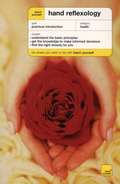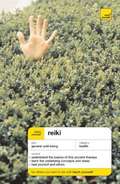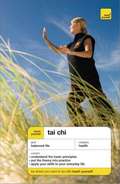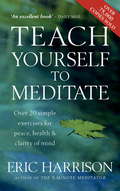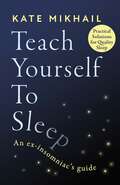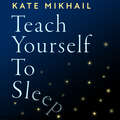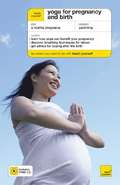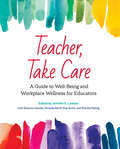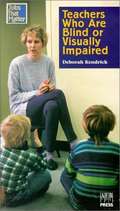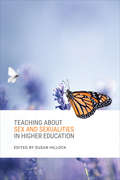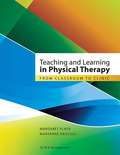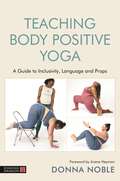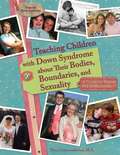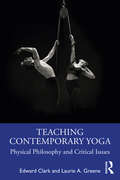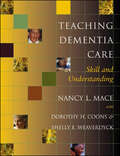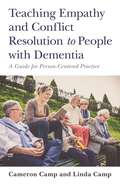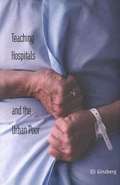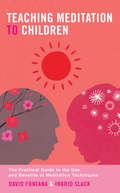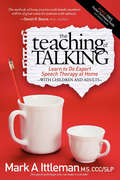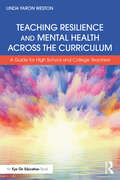- Table View
- List View
Teach Yourself Hand Reflexology
by Denise Whichello BrownHand Reflexology is a simple, straightforward and practical guide to this ancient and increasingly popular healing art. Discover how reflexology has an enormous part to play in healthcare and how it offers much more than just a hand massage. Explore the roots of reflexology, and learn techniques easily with step-by-step instructions and accompanying illustrations.
Teach Yourself Jung
by Ruth SnowdenCarl Jung (1875-1961) was a Swiss psychologist and psychiatrist who is famous for founding a new system of psychology that he called 'analytical psychology'. Jung has gradually acquired a huge following and many therapists today are trained in the Jungian method. However, his work also contains many important insights into the lives of humankind, far beyond the field of therapy, that have only recently begun to be more widely understood. He was one of the first great thinkers to try and bridge gaps between the thinking of East and West, Christian and pagan. He demonstrated ways in which Western culture, so bound up in science and logic, was often sadly deficient in the spiritual awareness and subjective insight shown in other cultures and at other times in history. This book provides a general introduction to both Jung and his work, and the section at the end, Taking it further, suggests ways in which you can continue your study of this fascinating and great thinker.
Teach Yourself Reiki
by Sandi Leir-ShuffreyLearn to use your energy to heal yourself and others. A practical guide to Reiki, Teach Yourself Reiki teaches you how to improve your own quality of life, as well as that of others, using the increasingly popular method of energy transference for healing purposes. Including real-life case studies of successful Reiki treatments, it also contains valuable information on becoming a Reiki Master.
Teach Yourself Tai Chi
by Robert ParryDo you want to understand the basic principles of Tai Chi? Do you want step-by-step instructions for the movements? Do you want to improve your basic health and fitness? Tai Chi explores the background and philosophy of the practice, introducing the "short yang form," ideal for all ages and fitness levels. Step-by-step guides to the movements will help you to reap many of the physical and mental benefits of this ancient Chinese system of exercise.
Teach Yourself To Meditate
by Eric HarrisonMany people are turning to meditation as an effective way to relax and bring inner peace. Meditation can help you to combat stress, improve your general health, increase your awareness and boost your capacity to think clearly and creatively.Teach Yourself to Meditate is the ideal guide for everyone who wants to learn this powerful technique. Throughout, there are easy-to-follow exercises and enjoyable 'spot meditations' which you can do any time, anywhere. By investing just a few minutes a day, you will learn a skill that will greatly improve the quality of your life. This excellent book explains:· what meditation is and why it works· how to do it· the 10 core meditation practices which work best for everyone.
Teach Yourself To Meditate: Over 20 simple exercises for peace, health & clarity of mind
by Eric HarrisonA clear and practical guide to learning meditation techniquesMany people are turning to meditation as an effective way to relax and find inner peace. Regular meditation can help you to combat stress, improve your general health, increase your awareness and boost your capacity to think clearly and creatively. Teach Yourself to Meditate is the ideal guide for everyone who wants to learn this powerful technique. This excellent book explains what meditation is, why it works and how to do it, as well as the 10 core meditation practices which work best for everyone. Throughout the book there are also easy-to-follow exercises and enjoyable 'spot meditations' which you can do any time, anywhere. By investing just a few minutes a day, you will learn a skill that will greatly improve the quality of your life.
Teach Yourself to Sleep: An ex-insomniac's guide
by Kate MikhailAre you suffering from chronic insomnia, an erratic sleep pattern or do you simply feel that your sleep isn't as deep and restorative as it should be? Then struggle no more. Teach Yourself to Sleep is the new, sustainable solution that you have been waiting for.After decades of trying traditional methods to cure her poor sleep, the chance reading of a book by her great-great uncle, a pioneer in cognitive therapy and clinical hypnosis, led chronic insomniac Kate Mikhail to research the science of sleep and the mind-body loop, and develop the tried-and-tested methods that have finally enabled her to take control of her sleep and wake up feeling rested and energised.In Teach Yourself to Sleep, Kate shares her approach, blending first-person experience with accessible sleep science and interviews with leading doctors, scientists and academics, as well as highly effective sleep 'scripts' provided exclusively for this book by sleep experts.Teach Yourself to Sleep will help you to view sleep in a wider, deeper context by revealing that its quality is inseparably woven into the way you spend your day - not an add-on that comes out of nowhere as night descends. Considering sleep from every angle - from the role of biology-based self-talk in reinforcing better sleep habits, to fixing your sleep-wake cycle through the right balance of light and darkness, and when, what and how to eat for the best sleep possible - this book will help you to understand your sleep better and give you the tools to take control and finally begin to get the sleep you need.
Teach Yourself to Sleep: An ex-insomniac's guide
by Kate MikhailPRACTICAL SOLUTIONS FOR QUALITY SLEEP'In her brilliant new book Mikhail delivers accessible science to help you take back control of your bedtime and your sleep' PsychologiesAre you suffering from chronic insomnia, an erratic sleep pattern or do you simply feel that your sleep isn't as deep and restorative as it should be? Then struggle no more. Teach Yourself to Sleep is the new, sustainable solution that you have been waiting for.After decades of trying traditional methods to cure her poor sleep, the chance reading of a book by her great-great uncle, a pioneer in cognitive therapy and clinical hypnosis, led chronic insomniac Kate Mikhail to research the science of sleep and the mind-body loop, and develop the tried-and-tested methods that have finally enabled her to take control of her sleep and wake up feeling rested and energised.In Teach Yourself to Sleep, Kate shares her approach, blending first-person experience with accessible sleep science and interviews with leading doctors, scientists and academics, as well as highly effective sleep 'scripts' provided exclusively for this book by sleep experts.Teach Yourself to Sleep will help you to view sleep in a wider, deeper context by revealing that its quality is inseparably woven into the way you spend your day - not an add-on that comes out of nowhere as night descends. Considering sleep from every angle - from the role of biology-based self-talk in reinforcing better sleep habits, to fixing your sleep-wake cycle through the right balance of light and darkness, and when, what and how to eat for the best sleep possible - this book will help you to understand your sleep better and give you the tools to take control and finally begin to get the sleep you need.
Teach Yourself to Sleep: An ex-insomniac's guide
by Kate MikhailPRACTICAL SOLUTIONS FOR QUALITY SLEEP'In her brilliant new book Mikhail delivers accessible science to help you take back control of your bedtime and your sleep' PsychologiesAre you suffering from chronic insomnia, an erratic sleep pattern or do you simply feel that your sleep isn't as deep and restorative as it should be? Then struggle no more. Teach Yourself to Sleep is the new, sustainable solution that you have been waiting for.After decades of trying traditional methods to cure her poor sleep, the chance reading of a book by her great-great uncle, a pioneer in cognitive therapy and clinical hypnosis, led chronic insomniac Kate Mikhail to research the science of sleep and the mind-body loop, and develop the tried-and-tested methods that have finally enabled her to take control of her sleep and wake up feeling rested and energised.In Teach Yourself to Sleep, Kate shares her approach, blending first-person experience with accessible sleep science and interviews with leading doctors, scientists and academics, as well as highly effective sleep 'scripts' provided exclusively for this book by sleep experts.Teach Yourself to Sleep will help you to view sleep in a wider, deeper context by revealing that its quality is inseparably woven into the way you spend your day - not an add-on that comes out of nowhere as night descends. Considering sleep from every angle - from the role of biology-based self-talk in reinforcing better sleep habits, to fixing your sleep-wake cycle through the right balance of light and darkness, and when, what and how to eat for the best sleep possible - this book will help you to understand your sleep better and give you the tools to take control and finally begin to get the sleep you need.
Teach Yourself Yoga
by Mary StewartSelf help of practicing yoga, gives tips and techniques on how yoga can really work.
Teach Yourself Yoga for Pregnancy and Birth
by Uma Dinsmore-TulliHave a healthy, happy pregnancy through yoga. Teach Yourself Yoga for Pregnancy and Birth offers you a way to stay healthy during your pregnancy and nurture your spiritual and emotional well-being. Inside you'll find breathing techniques and relaxation exercises to help during pregnancy and labor.
Teacher, Take Care: A Guide to Well-Being and Workplace Wellness for Educators
by Cher Brasok Monika Cichosz Rosney Laura Doney Dana Fulwiler Volk Jackie Gagné Megan Hunter Kelsey McDonald Keith Macpherson Lisa Dumas Neufeld Sandra Pacheco Melo Richelle North Scott Joyce SunadaTeaching can be a highly satisfying profession, but it can also be overwhelming. Stress management. Self-care. Mental well-being. Mindfulness. These words have become all too familiar, but what do they actually mean for you? And how can they help without adding to your to-do list?All teachers have different experiences and different needs. Through stories by diverse educators, this professional resource invites you to try different wellness strategies, explore varying perspectives, and consider new ideas of what it means to &“be well.&”Grounded in servant leadership and a holistic model, each chapter connects to Indigenous perspectives of wellness through remarks from Elder Stanley Kipling and Knowledge Keeper Richelle North Star Scott.
Teacher, Take Care: A Guide to Well-Being and Workplace Wellness for Educators
by Cher Brasok Monika Cichosz Rosney Laura Doney Dana Fulwiler Volk Jackie Gagné Megan Hunter Kelsey McDonald Keith Macpherson Lisa Dumas Neufeld Sandra Pacheco Melo Richelle North Scott Joyce SunadaTeaching can be a highly satisfying profession, but it can also be overwhelming. Stress management. Self-care. Mental well-being. Mindfulness. These words have become all too familiar, but what do they actually mean for you? And how can they help without adding to your to-do list?All teachers have different experiences and different needs. Through stories by diverse educators, this professional resource invites you to try different wellness strategies, explore varying perspectives, and consider new ideas of what it means to &“be well.&”Grounded in servant leadership and a holistic model, each chapter connects to Indigenous perspectives of wellness through remarks from Elder Stanley Kipling and Knowledge Keeper Richelle North Star Scott.
Teachers Who Are Blind or Visually Impaired
by Deborah KendrickThe first volume in the Jobs That Matter series, Teachers Who Are Blind or Visually Impaired profiles 18 visually impaired individuals who have successfully fulfilled their dreams of becoming teachers. Included in this volume are educators of different ages, ethnic backgrounds, and geographic locations across the United States, who work in the classroom in ways that are both surprisingly similar and dramatically different from one another. These engaging individuals demonstrate how visually impaired teachers can be effective in their jobs and achieve classroom success and satisfaction. Designed to inspire young people who are blind or visually impaired, their families, and the professionals who work with them about careers that are available, the books in the Jobs That Matter series are meant to expand readers' horizons by showing a wide range of employment possibilities.
Teaching about Sex and Sexualities in Higher Education
by Susan HillockTeaching about Sex and Sexualities in Higher Education argues that much more can be done in teaching about sex and sexuality in higher education. This edited collection provides key information on professional training and support, and acts as a crucial resource on sex, sexuality, and related issues. With a focus on diversity, this book features expert contributors who discuss key concepts, debates, and current issues across disciplines to help educators improve curriculum content. This collection aims to provide adequate and appropriate sex education training and opportunities to educators so that they may explore complex personal and emotional issues, build skills, and develop the confidence necessary to help others in their respective fields.
Teaching and Learning in Physical Therapy: From Classroom to Clinic
by Maryanne Driscoll Margaret M. PlackTeaching and learning are skills, and like other physical therapy skills, they must be learned and perfected. Teaching and Learning in Physical Therapy: From Classroom to Clinic offers a systematic approach to designing, implementing, and evaluating effective teaching-learning experiences. Each chapter begins with Objectives that clearly delineate what you will be prepared to do after completing the chapter and concludes with a Summary of the major concepts presented. Stop and Reflect sections allow you to actively engage with the content as you process the information and move through the chapters. Critical Thinking Clinical Scenarios provide multiple opportunities for you to apply and adapt key concepts to real world situations. Finally, concepts are reinforced through frequent Key Points to Remember sections. Drs. Margaret Plack and Maryanne Driscoll have over 35 years of experience in teaching, research, and clinical practice. Teaching and Learning in Physical Therapy is grounded in current literature and has a theoretical basis in reflective practice, active learning strategies, and brain compatible instruction. Also included in this text are practical strategies that allow students, educators, and clinicians, working with both students and patients, to enhance their critical thinking and clinical decision-making processes in a variety of settings and situations.
Teaching Body Positive Yoga: A Guide to Inclusivity, Language and Props
by Donna NobleDrawing on the philosophy and history of the body positivity movement, Donna Noble presents a radical re-examination of teaching inclusive yoga classes by breaking down stereotypes and demystifying yoga.By sharing accessible tools for everything from marketing a body-positive class to setting the scene in the space, using appropriate language and considering consent and touch, Noble demonstrates why every body is a yoga body - no matter what shape or size. With guidance on modifying poses for larger bodies, as well as chair-based sequences, this resource helps yoga teachers to ensure that the benefits of yoga are available to everyone.With practical tips, as well as information on social justice and body-positive yoga off the mat, Teaching Body Positive Yoga is a well-rounded resource that gives yoga teachers the confidence to host inclusive and welcoming classes for all.
Teaching Children with Down Syndrome about Their Bodies, Boundaries, and Sexuality: A Guide for Parents and Professionals
by Terri CouwenhovenParents of children with Down syndrome and other intellectual disabilties are accustomed to paying close attention to their child's physical, cognitive, and emotional development. This proactive approach should also include their child's sexual development, which for many parents may not seem as obvious or urgent, especially to those with young children. Drawing on her unique background as both a sexual educator and mother of a child with Down syndrome, the author blends factual information and practical ideas for teaching children with Down syndrome about their bodies, puberty, and sexuality. This book gives parents the confidence to speak comfortably about these sometimes difficult subjects. In an easy-to-read, non-clinical style, the book covers relevant issues and concerns for children of all ages, such as: labelling & explaining private body parts; Identifying & expressing emotions; Respecting personal space; Teaching self-care & hygiene; Understanding norms of privacy; Understanding gender identity; Showing appropriate levels of affection. It also covers issues that affect teenagers and young adults, including: Anticipating and understanding puberty; Dealing with periods, bras; Experiencing erections, wet dreams; Relating to the opposite sex; Sharing parental values about sexuality; Explaining sexual relationships; Preventing sexual abuse; Understanding how Down syndrome affects puberty & fertility rates. Each chapter highlights important points with key messages, teaching activities, parental pauses, and anecdotes, all of which prompt readers to stop and consider concepts or values associated with a particular topic. The final chapter covers the special concerns of parents who are now teaching teenaged or adult children about sexuality for the first time. It concludes with extensive appendices containing invaluable teaching materials and illustrations of body parts and functions.
Teaching Contemporary Yoga: Physical Philosophy and Critical Issues
by Edward Clark Laurie A. GreeneTeaching Contemporary Yoga provides a novel look at how modern yoga is understood, practiced, and taught globally. Utilising perspectives from several academic disciplines, the authors offer an analysis of the current state of modern yoga and the possibilities for future experimentation and innovation. The authors draw on anthropological, performance, and embodiment theories to understand yoga practice as a potentially powerful ritual of transformation as well as a cultural product steeped in the process of meaning making. They craft a unique analysis that contrasts asana with the largely unexamined philosophy underlying the practice of vinyasa, while imagining a vibrant future for the evolution of yoga through excellence in teaching. Unlike other writings about yoga, the authors offer a critique of the current practice of yoga as both diminished and utilitarian, while providing a path to reinvigorating the discipline based on current scientific knowledge and methods for teaching and practice. Along with these theoretical perspectives and the analysis of contemporary yoga in the West, the authors offer practical applications to address the challenges of teaching yoga in a society where individualism and materialism are core values. Open-ended exercises in reflection and experimentation offer opportunities for readers to apply what they have learned to their teaching and personal practice. This is a vital guide for any yoga-oriented scholar, teacher, or practitioner and is an essential companion for contemporary teacher training.
Teaching Dementia Care: Skill and Understanding
by Nancy L. MaceDementia afflicts millions of Americans and deeply affects the lives of their loved ones. Good care has been proven to have a significant effect on the quality of life of a person with dementia. To ensure good care, staff members of nursing homes, assisted living facilities, and adult day-care centers, and providers of home care must be thoroughly and continually trained by qualified and well-prepared professionals.Nancy L. Mace, coauthor of The 36-Hour Day, has created the ultimate teachers' guide for dementia care training. Rich with information and with tools for effective communication between teacher and student, the text supplies instructors with in-depth lessons and includes relevant charts, tables, and handouts, which may be customized to suit specific programs. Good training is the foundation for a confident and competent caregiver and supports the dignity and well-being of persons with dementia and their families. With her unmistakable compassion, humor, and wisdom, Mace has provided a much-needed guidebook for better teaching and better care.
Teaching Empathy and Conflict Resolution to People with Dementia: A Guide for Person-Centered Practice
by Cameron Camp Linda CampThe way in which dementia is understood and treated is changing, with a growing focus on the individual's experience and person-centred approaches to care. Introducing a new model of dementia care that reflects on the role of a person with dementia within a community and their relationships, this guide for professional and family caregivers demonstrates how to facilitate positive relationships for peaceful living. By understanding the cognitive and physical challenges that older adults with dementia face, caregivers can practice empathic care that affords people with dementia increased freedom of expression and independence. Included here are techniques for conflict resolution that enable people with dementia to be active and self-initiating in times of distress and disruption. Looking at the basics of respect, empathy, and mindfulness, this book also provides hands-on training for employing these virtues in practice with a number of exercises to help achieve the goal of peaceful independent living.
Teaching Hospitals and the Urban Poor
by Eli GinzbergAcademic health centers (AHCs) have played a key role in propelling the United States to world leadership in technological advances in medicine. At the same time, however, many of these urban-based hospitals have largely ignored the medical care of their poor neighbors. Now one of the leading experts in American health policy and economics ponders whether current and proposed changes in the financing and delivery of medical care will result in a realignment between AHCs and the poor. Basing his discussion on an analysis of the nation's twenty-five leading research-oriented health centers, Eli Ginzberg and his associates trace the history of AHCs in the twentieth century. He claims that AHCs are once again moving toward treating the poor because these hospitals need to admit more Medicaid patients to fill their empty beds, and their medical students need opportunities to practice in ambulatory sites. He also assesses some of the more important trends that may challenge the AHCs, including financial concerns, changing medical practice environments, and the likelihood of some form of universal health insurance.
Teaching Meditation To Children
by David Fontana Ingrid Slack"This book is for adults, and explains how to introduce children to meditation. The idea of teaching meditation to children is relatively new to the Western world, but in the East meditation has long been accepted as an essential part of early education, laying down skills which are of lifelong benefit. The book is intended for all adults who wish to teach meditation to children. That includes parents, school-teachers, youth leaders, social workers, psychologists, church workers, grandparents, uncles and aunts, and anyone who has contact with children in an official capacity and who wishes to help them make the best use of their extraordinary minds. This book is based upon our own experience as psychologists who have worked extensively with children, and who have written about and taught meditation to all age groups. Children are impressionable human beings, and very much open to direction and influence by adults. Thus any attempt to introduce them to meditation must be done sensitively and wisely (we have more to say about this in Chapter 2), and must empower them not only to meditate, but also to judge the usefulness of meditation for themselves. This ability to judge will allow them to decide whether or not meditation is right for them. Of all activities, meditation is perhaps the one where success most depends upon voluntary participation. In addition, as meditation involves working with one's own mind, children should be given the right to accept or reject it as they think fit. This book is intended to help you to introduce children to meditation easily and effectively, and in the right spirit."
The Teaching of Talking: Learn to Do Expert Speech Therapy at Home with Children and Adults
by Mark A. IttlemanIn this guide, a speech pathologist teaches readers the methods implemented to improve talking in others, so if need be, they can do therapy on their own. People with speaking difficulties are at the mercy of insurance companies who are determining how often and for how long speech therapy services should be delivered. It is also a disturbing reality that the likelihood for therapy frequency and length of care is contingent upon either the level of competence or comfort level of the speech-language pathologist or the financial policies of each institution. Often it has nothing to do with the severity or need for speech therapy. Our health care system is in no position to bankroll the long-term therapy needed by the many people who have moderate to profound speaking difficulties. The goal of The Teaching of Talking is to ensure that any loved one, caregiver, or speech-language pathologist is thoroughly knowledgeable in methods to help people improve talking since it is never known when the plug will be pulled on speech and language therapy services. Ittleman says, &“I see hundreds of people with speech and language difficulties each year. By reading and applying The Teaching of Talking, you will have the confidence to help your client or loved one, no matter what the insurance company or institution does. By learning to do what is in The Teaching of Talking, you will be more self-sufficient and will not have to rely on anyone to provide your loved one with expert speech therapy.&”&“The methods of home practice with family members will be of great value for patients with aphasia.&” —Daniel R. Boone, PhD, CCC/SLP
Teaching Resilience and Mental Health Across the Curriculum: A Guide for High School and College Teachers
by Linda Yaron WestonWritten by a teacher for teachers, Teaching Resilience and Mental Health Across the Curriculum is an integrative approach to pedagogy for educators at the high school and college level to survive, thrive, and sustain in the profession. Blending theory, research, and practice for a comprehensive program for teachers to incorporate well-being tools into the classroom, each of the book’s five foundations includes engaging information, strategies, real-world examples, interactive reflection questions, and activities that can be directly applied to teaching and life. Practical guidance in designing real-world curriculum is offered alongside accessible strategies for engagement, investment, and active learning in student-centered classrooms. An essential guide for teachers, it includes techniques for incorporating well-being that are grounded in culturally responsive teaching, trauma-informed instruction, mental health, resilience, and emotional literacy. Teachers will also gain insight on how to make the career sustainable through practices for self-compassion and authentic self-care so they can not only survive, but flourish in and out of school. For all the challenges that students and teachers face, this book defines what it means, and what it takes, to teach in today’s classrooms.
